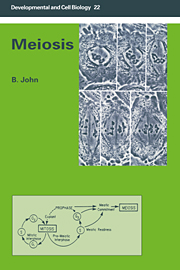Book contents
- Frontmatter
- Contents
- Acknowledgements
- Prologue
- 1 Introduction – multiplication and division
- 2 Modes of meiosis
- 3 Occurrence and timing of meiosis
- 4 Events and mechanisms of meiosis
- 5 Chromosome disjunction
- 6 The genetic control of meiosis
- 7 Sequences and consequences of meiosis
- 8 Evolutionary aspects of meiosis
- Postlogue
- References
- Index
4 - Events and mechanisms of meiosis
Published online by Cambridge University Press: 21 January 2010
- Frontmatter
- Contents
- Acknowledgements
- Prologue
- 1 Introduction – multiplication and division
- 2 Modes of meiosis
- 3 Occurrence and timing of meiosis
- 4 Events and mechanisms of meiosis
- 5 Chromosome disjunction
- 6 The genetic control of meiosis
- 7 Sequences and consequences of meiosis
- 8 Evolutionary aspects of meiosis
- Postlogue
- References
- Index
Summary
Models, of course, are highly seductive, especially where the realities of events are poorly known.
Herbert SternTHE SWITCH TO MEIOSIS
The precise factors responsible for the transition from mitosis to meiosis are still largely unknown. In mammals, as we saw earlier, while differentiation of the gonad into a recognizable testis occurs in the embryo, male germ cells do not enter meiotic prophase before early puberty. Fetal mouse testes and ovaries,together with their urinogenital connections, can be cultured either singly, or in pairs, on nucleopore filters. When a fetal testis is cultured in combination with older ovaries containing germ cells at prophase-1 of meiosis, the primordial male germ cells are triggered to enter meiosis(Byskov & Saxen, 1976). The female gonad thus appears to secrete a meiosis-inducing substance which can trigger indifferent male germ cells to enter meiosis. In keeping with this, XY cells in fetal mouse chimaeras also embark on meiosis and McLaren (1984) has proposed that they are stimulated to do so by the surrounding XX cells.
The specific somatic cell system that appears to be essential for the differentiation of the mammalian fetal ovary is the rete ovarii. Both the onset of female meiosis and follicle formation seem to depend on this urinogenital connection, of mesonephric origin, in the early gonadal anlage. When fetal testes with developed testicular cords are cultured in combination with ovaries of the same age, but which contain germ cells already in meiosis, the oocytes are prevented from reaching diplotene. This implies that the male gonads are producing some kind of meiosis-inhibiting substance. Unfortunately no diffusible inducing or inhibiting substances have yet been isolated.
- Type
- Chapter
- Information
- Meiosis , pp. 113 - 201Publisher: Cambridge University PressPrint publication year: 1990

